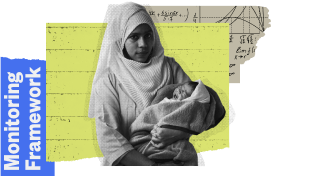Tanzania
Download full country profile
 66,455,900
Total Population
66,455,900
Total Population
A dispute exists between the Governments of Argentina and the United Kingdom of Great Britain and Northern Ireland concerning sovereignty over the Falkland Islands (Malvinas).
The boundaries and names shown and the designations used on this map do not imply official endorsement or acceptance by the United Nations.
Tanzania’s Population dynamics Data


Total Fertility Rate (births per woman)
Adolescent (15-19 years) Birth Rate (births per 1,000 girls)
Maternal mortality ratio (per 100,000 live births)
Tanzania’s national commitment
As part of the commitments made at the Nairobi Summit on ICPD25, the United Republic of Tanzania has committed to accelerating the implementation and funding of the ICPD Programme of Action, in line with the Tanzania Development Vision 2025. Tanzania has committed to enhancing efforts towards achieving the goal of zero unmet needs for family planning services to enhance child and maternal survival.
Tanzania is one of the eight countries where more than half of the projected increase in the global population up to 2050 will be concentrated.
In 2022, Tanzania’s total fertility rate (TFR) – the number of children that would be born to a woman if she were to live to the end of her childbearing years, is estimated to be 4.66. TFR and unmet need for family planning is highest among rural women, women with no or only primary education, and those in the poorest and second poorest households.
Tanzania is committed to increasing the modern contraceptive prevalence for all women to 42% by 2025. As part of this effort, it has been working to identify gaps in existing policies and guidelines to determine areas for review and harmonization, to develop knowledge and skills of service providers in postpartum and postabortion family planning, and to build capacity of health care providers with regards to proper self-care for short-term contraceptive methods, documentation, and report.
Tanzania’s national commitment
At the Nairobi Summit, Tanzania committed to enhancing efforts towards achieving the goal of zero preventable maternal deaths, and maternal morbidities. This includes a commitment to increase the national budget allocation for health to meet the Abuja declaration target of 15% and the commitment to roll out a competency-based curriculum for midwives by 2030 to enhance the provision of quality care. In addition, Tanzania is committed to accelerate the integration of HIV and other reproductive health services to reduce the burden of HIV, including reducing mother-to-child transmission to <5 percent by 2030.
Tanzania’s maternal mortality ratio (MMR) declined from 2000 to 2017, when it was estimated to be 524 maternal deaths per 100,000 live births; this rate falls halfway between that of countries in the region with the highest and lowest MMRs.
In 2016, 63.5% of births in Tanzania were attended by skilled health personnel and 62.6% of births were delivered at a health facility.
Among married women 15-49 years who had a live birth in the last two years, deliveries assisted by a skilled attendant were highest among women in urban areas, among women with secondary and higher education, and among women in wealthier households.
Tanzania’s national commitment
As part of the commitments made at the Nairobi Summit on ICPD25, Tanzania has committed towards ending sexual and gender-based violence of all forms, including zero child marriage, female genital mutilation, in order to realize all individuals’ potential as agents of change in their societies.
Tanzania has one of the highest child marriage rates in the region and in the world. Based on the latest available data, 30% of women aged 20-24 years were married before age 18, with 5% of women married before age 15.
Most women 20-24 years who were married before 18 years are those from rural areas (39%) compared with urban areas (18%). Approximately 65% of women married before age 18 have no education, while 39% have primary education. Marriage before age 18 is also highest among women living in the poorest (49%) and second poorest (47%) households.
Tanzania’s adolescent birth rate has remained relatively the same from 1990 to 2020, and is estimated to be 123 per 1,000 women aged 15-19 years old in 2022; it is one of the highest in the region.
Compared with the national rate, Tanzania’s adolescent birth rate is higher in rural areas (1.5 times higher than in urban areas), among girls with no education (nearly four times higher than girls with secondary or higher education), and among those living in the poorest households (three times higher than those in the richest households). Births among girls 15-19 years are higher among girls who live in rural areas, those with no education and primary education, and those girls from the poorest households.
Tanzania’s literacy rate is the same between males and females among those 15 to 24 years of age, while women aged 25 to 34 and 35 to 49 years of age have lower literacy rates than their male counterparts.
In Tanzania, the percentage of youth not in education, employment or training has remained relatively the same among men from 2008 to 2017, but has been increasing among women.
The main contributing factor for the country’s high level of population growth is fertility, with teenage pregnancy contributing highly to the large number of young people and children in proportion to the entire country’s population.
The impact of population growth upon poverty rates is compounded by variations in fertility rates across income groups and levels of education.
Despite its explicit ICPD25 commitment to harnessing the demographic dividend, unless additional measures are introduced to significantly reduce fertility rates, such as the rapid acceleration of current trends in the uptake of modern contraceptives, alongside efforts to tackle the underlying drivers of high birth rates, especially among the least educated, rural poor, Tanzania will not see a demographic dividend until after 2060.
Since the Nairobi Summit, Tanzania’s commitments were reflected in some of the country’s development and strategic documents, including the Health Sector Strategic Plan V and the National Family Planning Costed Implementation Plan. A tool to track ICPD commitments was developed at the regional level and customized at the country level.















































